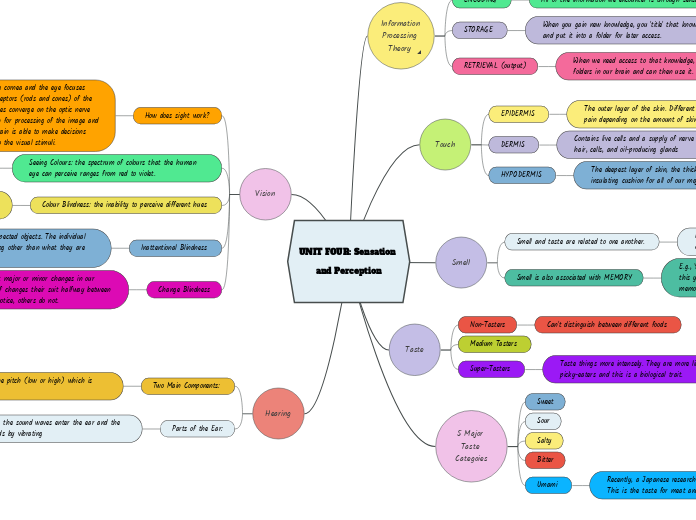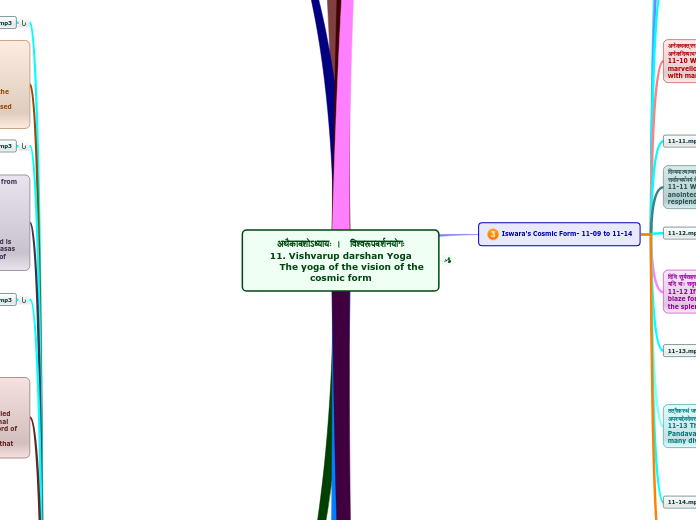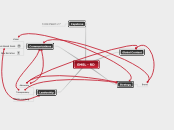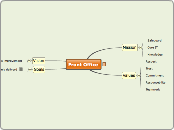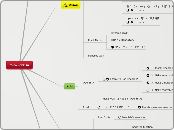UNIT FOUR: Sensation and Perception
Hearing
Parts of the Ear:
Outer Ear: where the sound waves enter the ear and the ear drum responds by vibrating
Middle Ear: vibrations are converted into a smaller force with 3 tiny bones (the hammer, anvil, and stirrup). This is beyond the ear drum and the vibrations against the bones send to the inner ear.
Inner Ear: Sound waves go into the cochlea (snail shaped structure) and stimulate extremely sensitive hair cells that create neuro signals for the brain. This is the point in which the brain can interpret the sound.
Two Main Components:
Frequency: Describes the pitch (low or high) which is measured in HERTZ
Amplitude: Describes the volume (loud or soft) which is measured in DECIBELS
Vision
Change Blindness
The inability to detect major or minor changes in our environment. E.g., Prof changes their suit halfway between class - some people notice, others do not.
Inattentional Blindness
The inability to detect unexpected objects. The individual has trouble noticing anything other than what they are focused on.
Colour Blindness: the inability to perceive different hues
TRICHROMATS: People who can see all 3 primary colours and distinguish hue.
MONOCHROMATS: People who are totally colour-blind and can't discriminate different wavelengths (this is due to the lack of cones in their retina)
DICHROMATS: The most common. People who can distinguish two of the three basic colours; difficulty distinguishing yellow and blue or red and green.
Seeing Colours: the spectrum of colours that the human eye can perceive ranges from red to violet.
HUE: The colour of an object determined by the wavelengths of reflected light.
BRIGHTNESS: The lightness or darkness of reflected light, determined by the lights intensity.
SATURATION: The depth and richness of the colour
How does sight work?
Light passes through the cornea and the eye focuses images onto the photoreceptors (rods and cones) of the retina. The retinas impulses converge on the optic nerve and are sent to the brain for processing of the image and its meaning. Then, the brain is able to make decisions regarding how to react to the visual stimuli.
5 Major Taste Categoies
Umami
Recently, a Japanese research team developed this scent. This is the taste for meat and MSG
Bitter
Salty
Sour
Sweet
Taste
Super-Tasters
Taste things more intensely. They are more likely to be picky-eaters and this is a biological trait.
Medium Tasters
Non-Tasters
Can't distinguish between different foods
Smell
Smell is also associated with MEMORY
E.g., You are walking somewhere and something smells this your grandma's baking. You relate the smell to a memory.
Smell and taste are related to one another.
For EXAMPLE: When you are sick with a runny nose, you can't taste accurately.
Touch
HYPODERMIS
The deepest layer of skin, the thickest, and acts as an insulating cushion for all of our major organs
DERMIS
Contains live cells and a supply of nerve endings, blood, hair, cells, and oil-producing glands
This is THICKER than the epidermis
EPIDERMIS
The outer layer of the skin. Different sensory receptors for pain depending on the amount of skin in the area.
Can be thick or thin skin. It regenerates every 28 days and is very resilient to scratches and scrapes.
Information Processing Theory
RETRIEVAL (output)
When we need access to that knowledge, we go to our folders in our brain and can then use it.
STORAGE
When you gain new knowledge, you 'title' that knowledge and put it into a folder for later access.
We unconsciously assign meaning to things. Some things are stored in long-term memory and others are in short-term memory.
ENCODING
All of the information we encounter is through sensation.
We use our 5 SENSES to experience the world.
